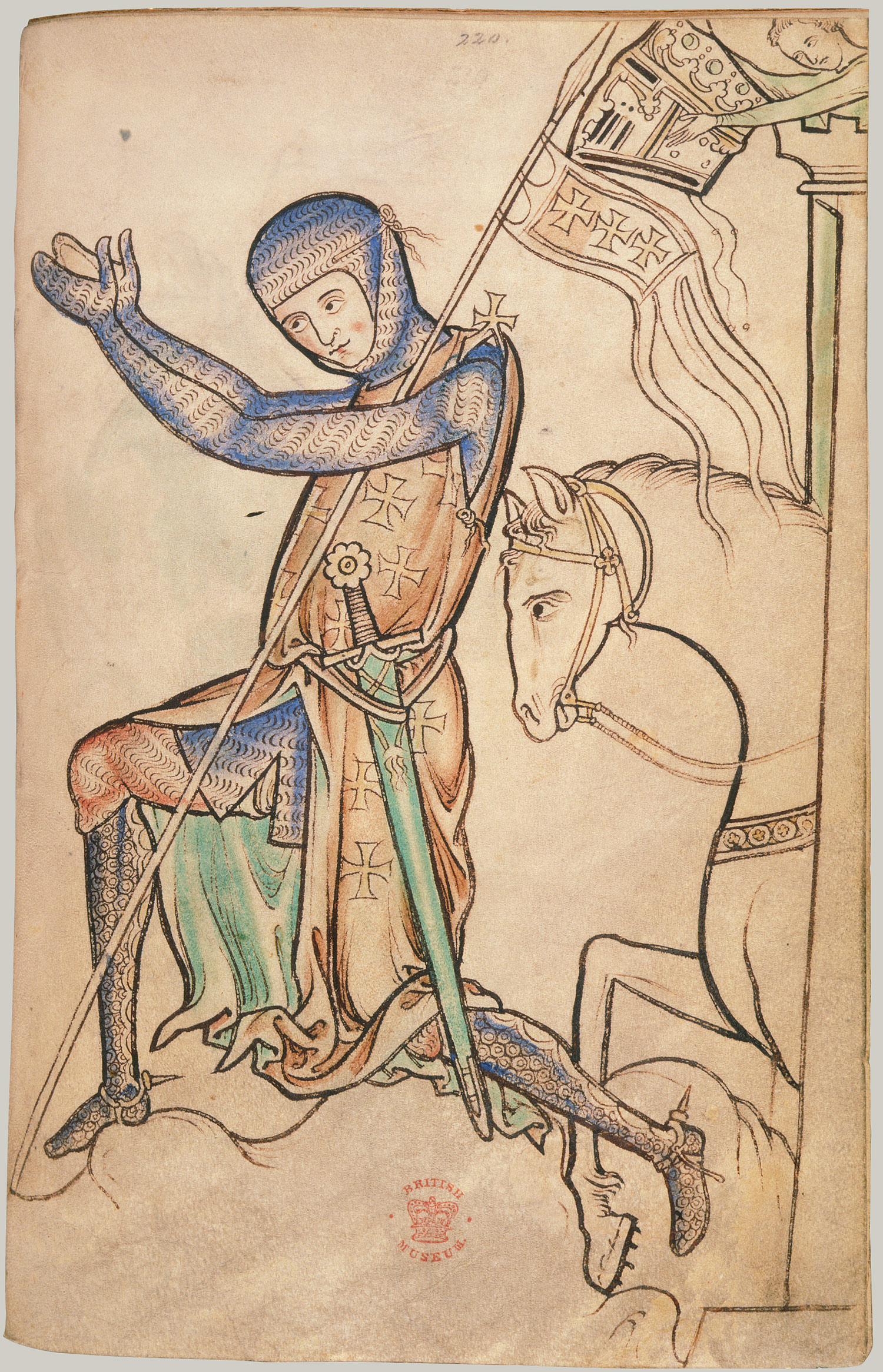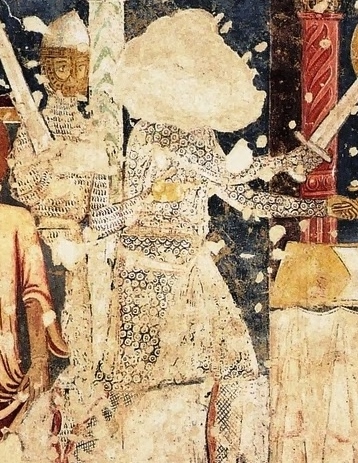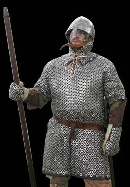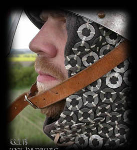| Author |
Message |
|
Stefan v Bischhoffshausen
Location: Chile Joined: 14 Nov 2013
Posts: 3
|
 Posted: Thu 14 Nov, 2013 5:29 pm Post subject: pictoric evidence of ring armor Posted: Thu 14 Nov, 2013 5:29 pm Post subject: pictoric evidence of ring armor |
 |
|
I just came across this image, which clearly depicts some kind of ring armor in the lower leg area.

(sorry for low res)
Looks like metal washers fastened to a textile base.
I'm thinking about reproducing this piece just for curiosity. Theoretically, it should disperse
the energy of the blow better than mail, wich would be useful in the shin area.
I know there is no archaeological evidence of any armor other than mail for this time period, but
is there any other pictorial or written evidence for this kind of armor?
Thanks[/img]
|
|
  |
 |
|
Eric Allen
|
 Posted: Thu 14 Nov, 2013 6:13 pm Post subject: Posted: Thu 14 Nov, 2013 6:13 pm Post subject: |
 |
|
I'm unconvinced that represents "ring armor" and not just the artist using a different convention for depicting "standard" maille. Although it does appear discongruous with the rest of the image. Perhaps the grain is falling open (i.e. the maille is rotated 90-degrees from the way its normally worn, so the rings are separating instead of overlapping as normal).
Or, maybe the rings represent decorative rivet heads on studded leather or an early sort of brigandine?
|
|
  |
 |
Dan Howard

|
 Posted: Thu 14 Nov, 2013 6:33 pm Post subject: Posted: Thu 14 Nov, 2013 6:33 pm Post subject: |
 |
|
Yep. We don't have a shred of evidence for medieval ring armour apart from some ambiguous illustrations.
http://www.arador.com/armour/chain-mail/
A neat experiment is to show a mail shirt to a classroom of kids and ask them to draw it. You'll see all of the variations that we find in the medieval illustrations and more.
Keep in mind that the most common threat was from arrows and spears. Another neat experiment is to make a patch of ring armour and see how it holds up against these weapons. Unless the rings are very small (c. 5mm) and assembled closely together, it is completely useless except for the occasional fluke shot that bounces off a ring.
If you make riveted mail from 8-10mm links (ID) then the gaps between those links are closer to 4mm because of the interwoven nature of the construction. If you make ring armour from the same rings then the gaps are 8-10mm, which is more than enough to let some arrows and javelins to pass through without touching the ring and it becomes a lot eassier for larger points to bust open a ring.
The only excuse people have come up with for the existence of ring armour is the "fact" that it is faster and cheaper to make than riveted mail. One needs to consider how these rings are actually manufactured using the available medieval technology and whether it really is much cheaper or faster than riveted mail. I'm not sure that there would be much of a difference.
Author: Bronze Age Military Equipment, Pen and Sword Books
|
|
  |
 |
Ahmad Tabari

|
 Posted: Thu 14 Nov, 2013 7:29 pm Post subject: Re: pictoric evidence of ring armor Posted: Thu 14 Nov, 2013 7:29 pm Post subject: Re: pictoric evidence of ring armor |
 |
|
| Stefan v Bischhoffshausen wrote: | | Looks like metal washers fastened to a textile base.[/img] |
It looks more like scale to me.
I have to agree with Dan. Armour made of iron rings sewn to a leather/fabric backing would not be very useful against arrows and spears. The bigger the rings, the less effective the armour would be. And if small rings (mail sized) were used, the armour would take just as long to prepare and would still not be as effective.
|
|
  |
 |
Ahmad Tabari

|
 Posted: Thu 14 Nov, 2013 7:37 pm Post subject: Posted: Thu 14 Nov, 2013 7:37 pm Post subject: |
 |
|
Welcome to the forum by the way 
|
|
  |
 |
|
Stefan v Bischhoffshausen
Location: Chile Joined: 14 Nov 2013
Posts: 3
|
 Posted: Fri 15 Nov, 2013 7:07 am Post subject: Posted: Fri 15 Nov, 2013 7:07 am Post subject: |
 |
|
I fully agree with the notion that mail is far superior than any reconstruction of armor that has been tried.
Actually I've tried many kinds of armor, including hollywood style leather stuff, gambesons of various thicknesses, butted and riveted mail, scale, lamellar, splinted. Nothing I have tried comes even close to the "protection/weight ratio" and comfort of riveted mail.
It would be reasonable to think that if this armor really existed it would have been very uncommon and offer little advantage over mail, if any. But then, why was it used in this case? I think the "cheaper and faster" excuse would not apply to a knight.
That's the reason why I'm so courious about this image. If it is real and not just an artisctic license, there must be a reason strong enough for that knight to use that piece of armor. I feel like I'm missing something.
It might be a different form of depicting regular mail but I highly doubt it, since this manuscript is very detailed and consistent in the way of depicting mail (wich is not the case in most other sources like the bayeux tapestry and other manuscripts).
It could be an early form of brigandine, but the lacing in the back (just like mail chausses) suggests that it is more flexible.
If I make a reproduction I will share the testing results here.
PD: I just noticed that the horse has a row of rings or washers in the neck strap (or whatever it is called). It might just be coincidence.
BTW thank you! I have been reading this forum for a while, and really like the level of discussion. People here really know what they are talking about.
|
|
  |
 |
Luka Borscak

|
 Posted: Fri 15 Nov, 2013 7:42 am Post subject: Posted: Fri 15 Nov, 2013 7:42 am Post subject: |
 |
|
|
Even if it's not mail, it could be several things rather than "ring mail". It might be scale or cuir bouilli with some kind of circular decoration on it.
|
|
  |
 |
|
Mart Shearer
|
 Posted: Fri 15 Nov, 2013 8:07 am Post subject: Posted: Fri 15 Nov, 2013 8:07 am Post subject: |
 |
|
If you want the higher resolution image
http://molcat1.bl.uk/IllImages/BLStudio/big/Roy2AXXII/220.jpg
The centers of the roundels on the horse's breast band are quatrefoils rendered in a color which might indicate brass or gilt décor.
The knight's lower leg armor might be interpreted as a number of things:
1. Mail made of large rings
2. Round plates fastened to a leather or fabric base with a central rivet
3. Washers or rings fastened to a leather or fabric base by sewing
There are a large number of methods used in miniatures to depict common mail: Cross-hatching, dots, circles, rows of commas, solid lines dividing rows of dots or commas, gray washes, etc.. It is impossible to dismiss this depiction as being mail simply because it differs from that used on the body or thigh. The fact is that one miniature is not proof that a given construction was used.
EDIT: I thought I'd add the famous fresco of the Martyrdom of Becket from the Church of Sts. John and Paul (Chiesa dei Santi Giovanni e Paolo) in Spoleto, Italy. Here we see the same sort of depiction on the hauberk of fitzUrse though his chausses are crosshatched like screen wire. The knight behind him in the oft-copied helm has mail portrayed in rows of commas.
http://4.bp.blogspot.com/-NDz7HQX5kgw/Ul5Y5By...P24079.jpg
 Attachment: 191.62 KB Attachment: 191.62 KB

ferrum ferro acuitur et homo exacuit faciem amici sui
|
|
  |
 |
Ahmad Tabari

|
 Posted: Fri 15 Nov, 2013 1:38 pm Post subject: Posted: Fri 15 Nov, 2013 1:38 pm Post subject: |
 |
|
|
Having taken a close look at the higher resolution image provided by Mart, I am now convinced this is neither mail nor scale armour. If you look at the thigh area, you will find that the illustration clearly shows that the knight is wearing mail leggings. And it seems this is an additional layer of shin protection with some sort of backing. Perhaps sewing large iron rings to leather backing would make for stiff and inflexible armour well suited for limb protection. Though this seems to have been a supplement to mail rather than a replacement for it. But of course we need more data to make a solid conclusion with regards to what indeed seems like "ring armour".
|
|
  |
 |
Dan Howard

|
 Posted: Fri 15 Nov, 2013 1:38 pm Post subject: Posted: Fri 15 Nov, 2013 1:38 pm Post subject: |
 |
|
| Stefan v Bischhoffshausen wrote: | It might be a different form of depicting regular mail but I highly doubt it, since this manuscript is very detailed and consistent in the way of depicting mail (wich is not the case in most other sources like the bayeux tapestry and other manuscripts).
It could be an early form of brigandine, but the lacing in the back (just like mail chausses) suggests that it is more flexible. |
The ties on the back of the calf are a good indicator that it is plain old regular mail - probably a different weave to the rest of his armour. These things aren't photos and cannot be treated as such.
Author: Bronze Age Military Equipment, Pen and Sword Books
|
|
  |
 |
|
Mart Shearer
|
 Posted: Fri 15 Nov, 2013 5:07 pm Post subject: Posted: Fri 15 Nov, 2013 5:07 pm Post subject: |
 |
|
| Ahmad Tabari wrote: | | If you look at the thigh area, you will find that the illustration clearly shows that the knight is wearing mail leggings. And it seems this is an additional layer of shin protection with some sort of backing. |
In regards to the Westminster Psalter knight, I would have to suggest clarification. I suspect we are seeing an additional layer over the thigh. The bronze-colored mail seems to be a cuisse and not a chausse. There is no indication that this mail continues below the knee, and it is not visible in the open backs of the shin armor. There does appear to be some sort of edge to the large ring armor, which might be interpreted as a backing material, but other contemporary miniatures and art support the idea that these are partial mail chausses, laced in the back beneath the mail cuisses. So there is no way to be certain what the depiction is indicating over the shins. In my opinion the bulk of evidence supports that these are mail chausses beneath mail cuisses, but there is some reasonable doubt that it could be an alternate construction.
Thom Richardson cites BL, Add. MS 60584, f. 12r giving evidence of mail cuisses distinguished from chausses.
| Quote: | In the receipt of the armoury of Edward II we find a relatively small
collection of mail ‘eleven mail shirts, fourteen pairs of mail leg defences or chausses,
six mail coifs (tenis pro guerra); ‘seven hauberks, one for a child, seven pairs of
mail chausses, five mail coifs, five pairs of mail cuisses, and a mail collar’; |
Other miniatures showing the open-back partial mail chausses:
[url]http://manuscriptminiatures.com/search/?tags="partial mail chausses"[/url]
Since we have evidence of standard 4:1 mail being made with rings of varying sizes, the large rings could simply be an attempt to distinguish mail with an external diameter of 15mm+ from that of 8mm outer diameter.
ferrum ferro acuitur et homo exacuit faciem amici sui
|
|
  |
 |
Corey Skriletz

Location: United States Joined: 27 May 2011
Posts: 118
|
 Posted: Fri 15 Nov, 2013 7:55 pm Post subject: Posted: Fri 15 Nov, 2013 7:55 pm Post subject: |
 |
|
As I understand it, maille was extremely expensive (I believe I've read some accounts that maille armor was passed down from father to son). That being the case, it might not have been an extremely common practice to buy an entire suit of maille all at once. This picture may represent a man who bought his hauberk and coif at a different time than he bought his chausses. As such, the chausses he bought may have been made by an armorer who used different diameter rings, or a different style, etc. Of course, this is merely speculation on my part, and I haven't any explanation why the thigh protection (which I agree with Mart is a cuisse) is styled in the same way as the hauberk.
At any rate, here are some pictures of other guys' interpretations of ring maille.
 Attachment: 34 KB Attachment: 34 KB

 Attachment: 40.75 KB Attachment: 40.75 KB

|
|
  |
 |
|
Mart Shearer
|
 Posted: Fri 15 Nov, 2013 8:49 pm Post subject: Posted: Fri 15 Nov, 2013 8:49 pm Post subject: |
 |
|
I must agree with Dan in that medieval manuscript miniatures, wall paintings, or enameled plaques are not photographs. We simply can't get too critical of such representations, or expect them to show every detail in a realistic manner. The accepted representation of rows of commas doesn't show mail made of interlinked rings any more realistically than the doubled circles. We have simply come to understand one representation and not the other as being more clear, perhaps because it is more common. In miniatures where the artist tries to show the interlinked rings, we can argue that he has drawn them too large!
http://molcat1.bl.uk/IllImages/Kslides/big/K002/K002251.jpg
Another issue is one of modern photographs bringing more detail than the original viewer might have had access to gaze upon. An example would be a detailed photograph of the Bayeux Tapestry, which would have been mounted high on the wall. A telephoto shot of a stained glass cathedral window gives a view of details not available to the standard 13th century observer celebrating mass. This enlarged view of a panel from the Verdun Altar might leave us debating if this is scale or mail:
http://armourinart.com/248/398/
However, a view compatible with what people see from 5 feet away might lead us to see mail or coarse mail:
http://www.stroccoglencove.com/mass-scarament...br-Mel.jpg
http://4.bp.blogspot.com/_3VAxr-ug0DU/TLn5fo_...CN3027.JPG
Every depiction of these back-laced chausses seems to indicate mail, with modern viewers only questioning the miniature in the Westminster Psalter. Perhaps the difference in depiction is more significant to us than the typical 13th century viewer?
ferrum ferro acuitur et homo exacuit faciem amici sui
|
|
  |
 |
|
Colt Reeves
|
 Posted: Sat 16 Nov, 2013 11:15 am Post subject: Posted: Sat 16 Nov, 2013 11:15 am Post subject: |
 |
|
I was going to chime in and suggest that the OP's example might be that his mail simply doesn't go all the way around the calf and what we see is a loose "shoe-lacing", but I see Mart Shearer beat me to it with plenty of examples. It's not like this would be the first example we've ever seen of mail being tied or secured with string.
"Tears are for the craven, prayers are for the clown.
Halters for the silly neck that cannot keep a crown.
As my loss is grievous, so my hope is small.
For Iron, Cold Iron, must be master of men all..."
-Cold Iron, Rudyard Kipling
|
|
  |
 |
|
Ralph Grinly
|
 Posted: Sat 16 Nov, 2013 12:42 pm Post subject: Posted: Sat 16 Nov, 2013 12:42 pm Post subject: |
 |
|
|
I tend to agree with most in assuming what is being represented as plain, old, classical mail. I suspect one possible reason the artist chose to depict it differently is that it "looked" different. Given that what's represented seems to be laced to the leg. I'd imagine that the lacing would need to be tight enough to 'stretch' the mail out..giving it a different appearance ? The only evidence I've ever seen of any mail that could be remotely considered "Ring mail" is some of the varieties of Japanese -made mail. I don't think I've ever seen any suggestions that particular style was ever know or used in a European setting, of any period ?
|
|
  |
 |
|
Mark Griffin
Location: The Welsh Marches, in the hills above Newtown, Powys. Joined: 28 Dec 2006
Posts: 802
|
 Posted: Sat 16 Nov, 2013 2:03 pm Post subject: Posted: Sat 16 Nov, 2013 2:03 pm Post subject: |
 |
|
|
well my favourite reconstruction of any form of mail defence was someone in a black neoprene onesie wetsuit that they had painstakingly drawn on in silver marker pen each and every ring. It was a sight to behold.
|
|
  |
 |
Dan Howard

|
 Posted: Sat 16 Nov, 2013 2:49 pm Post subject: Posted: Sat 16 Nov, 2013 2:49 pm Post subject: |
 |
|
| Ralph Grinly wrote: | | I tend to agree with most in assuming what is being represented as plain, old, classical mail. I suspect one possible reason the artist chose to depict it differently is that it "looked" different. Given that what's represented seems to be laced to the leg. I'd imagine that the lacing would need to be tight enough to 'stretch' the mail out..giving it a different appearance ? The only evidence I've ever seen of any mail that could be remotely considered "Ring mail" is some of the varieties of Japanese -made mail. I don't think I've ever seen any suggestions that particular style was ever know or used in a European setting, of any period ? |
There was a thread here with a photo of an eyelet doublet that had iron rings sewn throughout it. I would class that as ring armour.
http://www.myArmoury.com/talk/files/sheisjoppe_crop_223.jpg
But the rings are concealed within the stitching and would not be depicted by artists
Author: Bronze Age Military Equipment, Pen and Sword Books
|
|
  |
 |
Eric S

|
 Posted: Sat 16 Nov, 2013 7:07 pm Post subject: Posted: Sat 16 Nov, 2013 7:07 pm Post subject: |
 |
|
| Ralph Grinly wrote: | | The only evidence I've ever seen of any mail that could be remotely considered "Ring mail" is some of the varieties of Japanese -made mail. |
Japanese mail (kusari) is mail, none of the many varieties of it resemble ring mail. The Japanese did use coins sewn to a backing to make some armor.

Actual ring armor. Sudanese ring armor was taken by the Devon Yeomanry Battalion from the hut of the Khalifa, Abdallahi Ibn Muhammad, who replaced the Sudanese Mahdi and lead the Mahdists warriors against the British army in the battle of Omdurman, Sept. 1898, steel rings sewn with leather strips on a leather and heavy fabric back. 13 X 18 inches. This armor was displayed in the Devon Yeomanry museum in the UK.

|
|
   |
 |
Dan Howard

|
 Posted: Sat 16 Nov, 2013 7:12 pm Post subject: Posted: Sat 16 Nov, 2013 7:12 pm Post subject: |
 |
|
There are north Asian examples too. The best-known one is in Stone's Glossary. The Sudanese also used butted mail around the same time as that ring armour because they only needed it to stop blade edges. It was useless against arrows and spears, which were by far the most common threat during the time in which we are interested.
Author: Bronze Age Military Equipment, Pen and Sword Books
|
|
  |
 |
Eric S

|
 Posted: Sat 16 Nov, 2013 9:09 pm Post subject: Posted: Sat 16 Nov, 2013 9:09 pm Post subject: |
 |
|
| Dan Howard wrote: | | There are north Asian examples too. The best-known one is in Stone's Glossary. The Sudanese also used butted mail around the same time as that ring armour because they only needed it to stop blade edges. It was useless against arrows and spears, which were by far the most common threat during the time in which we are interested. |
Dan, while it seems that the Sudanese only manufactured butted mail they did use purchased or captured riveted mail along with their own butted mail and they did have to fight against spears and probably arrows since they battled other native African people including Ethopia as well other Sudanese people who did not exactly approve of the Mahdi's strict interpretation of Islam. The Eqyptians and British who the Sudanese also fought against probably used lances as well.
The images of ring and coin armor just show that anything is possible, the fact that armor of this type was known and used by several different cultures at different times means that it could also have been used in earlier European time periods as well, while you are right that arrows and spears were common weapons used in Europe during the time period mentioned there are situations were armor like this would have been better than nothing. Using existing ring type material or punching rings and sewing them to a backing would have been a cheap, fast way of making armor. Not everyone could afford mail and not all fighting involved arrows and spears. As you mentioned this type of armor would have been effective against blade edges. I am not saying it was used, I am just saying that you can not absolutely say it was not used.
Native american (Sitka Alaska) Tlingit leather war dress plated with Chinese coins. The Tlingit received Chinese coins in trade from Boston sea merchants in exchange for sea otter pelts.

|
|
   |
 |
|
|

